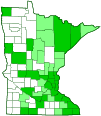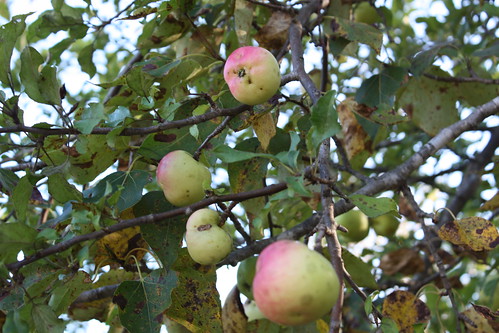apple
(Malus domestica)
Conservation • Description • Habitat • Ecology • Use • Distribution • Taxonomy
|
|
|||||||||||||
Description |
apple, also called common apple or just apple, is a small deciduous tree that reaches up to 50′ in height at maturity. The trunk is twisted. When grown in the open, the trunk divides near the ground into several major branches, and the crown is often as wide or wider than tall. When grown among other trees the trunk is taller and the crown is less spreading. Older branches on mature trees develop numerous prominent spur branches. The bark on young trees is smooth. On mature trees the bark is rough and thin, with a reddish inner bark and a gray, scaly outer bark. The twigs are moderately stout, brown to gray, and hairy when young. There are no thorns. The pith is solid and star-shaped in cross section. The leaf scars are narrow, slightly curved, and level with the twig or only moderately raised. They have 3 bundle scars. The buds are egg-shaped and are densely covered with whitish, woolly hairs. The leaves are deciduous, alternate, elliptical to egg-shaped, and 1½″ to 4″ long. They are entire, not lobed. They are rounded at the base and bluntly pointed at the tip. They are on leaf stalks that are densely covered with whitish hairs. The upper surface of the leaf blade is dark green and hairless. The lower surface is densely covered with whitish hairs. The margins are finely toothed. The flowers are large, up to 1¼″ wide. They appear after the leaves unfold in the spring. They are borne in umbrella-like clusters (umbels) on short, spur branches. There are 5 green sepals, 5 white petals tinged with pink, and 15 to 50 stamens with yellow anthers. The stamens are shorter than the petals. The fruit is a fleshy, globe-shaped to somewhat egg-shaped pome, 2⅜″ to 4⅓″ in diameter. Fruit of naturalized trees is smaller than fruit of those grown in cultivation because the latter are propagated by grafting. Naturalized trees produce fruit more than 1½″ in diameter. The fruit is green at first, turning yellow to red when it ripens in the mid- to late summer. The seed-bearing core or the pome is divided into 3 to 5 chambers. Each chamber normally contains 2 seeds. |
Height |
Up to 50′ |
Record |
No records are kept for non-native species. |
Flower Color |
White tinged with pink |
Similar Species |
The flowers are pink in bud but usually white when expanded, sometimes pink. Prairie crabapple (Malus ioensis) flowers are pink but sometimes fade to white. |
Habitat |
Roadsides, railroads, shores, fields, old homesteads, wooded areas. |
Ecology |
Flowering |
Late April to early May |
Pests and Diseases |
|
Use |
|
Distribution |
||
|
Sources The counties in light green reflect citizen science sightings posted on iNaturalist. Some if not most of those are trees in people’s yards, which are not “outside of cultivation.” |
|
| 5/7/2024 | ||
Nativity |
||
Native to eastern Europe. Introduced in colonial times. Widely cultivated. Occasionally escaped. |
||
Occurrence |
||
Uncommon Most occurrences of this tree outside of cultivation are probably the result of discarded apple cores by humans. |
||
Taxonomy |
|
Kingdom |
|
Division |
Tracheophyta (Vascular Plants) |
Subdivision |
Spermatophytina (Seed Plants) |
Class |
|
Order |
Rosales (Roses, Elms, Figs, and Allies) |
Family |
Rosaceae (Rose) |
Subfamily |
Amygdaloideae |
Tribe |
Maleae |
Subtribe |
Malinae |
Genus |
Malus (apples) |
Until recently, this species was known by the common name “paradise apple” and the scientific name Malus pumila. There has been an increasing use of the name Malus domestica in the 21st century. While the new species epithet seems relevant, it is taxonomically invalid. Nevertheless, in 2017, the International Code of Nomenclature for algae, fungi, and plants adopted Malus Domestica as a conserved name, making its use legitimate. Paradise apple is just one of several apples subsumed within Malus Domestica. All are now known by the scientific name Malus Domestica and the common name “orchard apple”, “domestic apple”, or simply “apple”. |
|
Subordinate Taxa |
|
|
|
Synonyms |
|
GBIF lists 250 synonyms of this species, far too many to include here. |
|
Malus communis Malus frutescens Malus paradisiaca Malus pumila Malus sylvestris Pyrus dioica Pyrus malus Pyrus malus var. paradisiaca Pyrus pumila |
|
Common Names |
|
apple common apple domestic apple orchard apple paradise apple |
|
Glossary
Pome
A fruit with a central seed bearing core enclosed in thick flesh, e.g., an apple or pear.
Umbel
A flat-topped or convex, umbrella-shaped cluster of flowers or buds arising from more or less a single point.
Visitor Photos |
||
Share your photo of this plant. |
||
This button not working for you? |
||
|
||
|
||
MinnesotaSeasons.com Photos |
||
 |
 |
|
Plant |
||
 |
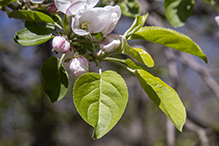 |
|
Leaves |
||
 |
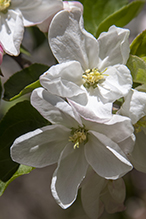 |
|
Inflorescence |
||
|
||
|
||
|
Flowers | |
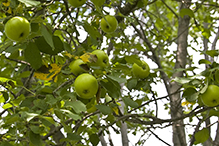 |
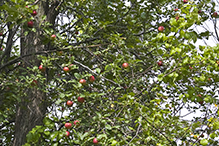 |
|
| Infructescence |
|
|

Visitor Videos |
||
Share your video of this plant. |
||
This button not working for you? |
||
|
Other Videos |
||
Malus domestica Apple Trees |
About
Uploaded on Oct 24, 2010 Old mature apple trees, fruiting well |
MALUS DOMESTICA |
About
Uploaded on Apr 23, 2009 Apfelblüten am 23-April-2009 In Emmenbrücke |

Visitor Sightings |
||
Report a sighting of this plant. |
||
This button not working for you? |
||
Charles Schaffer |
Location: Bruce Vento Wildlife Trail, Saint Paul Mn 55107, growing along the Mississippi bluff, near the Pickerel Lake trail overlook that descends to Lilydale Regional Park wow! the largest flowers I have seen and nicely fragrant. |
|
| Carol Whittaker 9/29/2023 |
Location: New Hamburg Ontario Canada It has been growing beside my fence since I moved into my house eight years ago, never knew what it was until today. |
|
MinnesotaSeasons.com Sightings |
||

|
Created: Last Updated: © MinnesotaSeasons.com. All rights reserved. |
